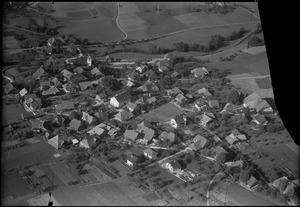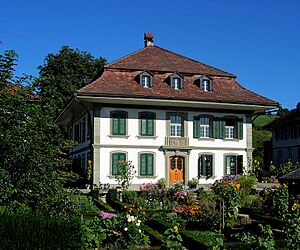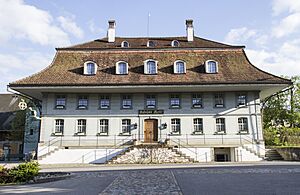Dürrenroth facts for kids
Quick facts for kids
Dürrenroth
|
||
|---|---|---|
|
||
| Country | Switzerland | |
| Canton | Bern | |
| District | Emmental | |
| Area | ||
| • Total | 14.13 km2 (5.46 sq mi) | |
| Elevation | 698 m (2,290 ft) | |
| Population
(Dec 2020 )
|
||
| • Total | 1,052 | |
| • Density | 74.45/km2 (192.83/sq mi) | |
| Postal code |
3465
|
|
| Surrounded by | Affoltern im Emmental, Huttwil, Rohrbachgraben, Sumiswald, Walterswil, Wyssachen | |
| Twin towns | Klenčí pod Čerchovem (Czech Republic) | |
Dürrenroth is a small town, also called a municipality, located in the Swiss canton of Bern. It's part of the Emmental district.
Contents
History of Dürrenroth
Dürrenroth was first mentioned in old records in 1275. Back then, it was simply called Rota. Later, in 1326, its name changed to Durren Rot.
People likely started settling in this area during the Late Middle Ages. These were mostly farmers living in scattered homes. In 1312, the area of Balm, which included Dürrenroth, was given to the Teutonic Knights. They were a religious military group.
Later, in 1431, the village became part of the city of Burgdorf in Bern. Around 1528, Bern adopted a new religion called the Protestant Reformation. Dürrenroth was also made to change its religion that same year, even though some villagers didn't want to. In 1698, Bern fully bought the village from the Teutonic Knights. This made Dürrenroth completely part of the Canton of Bern.
The village church, St. Lawrence, was built in 1486. It has been updated several times since then.
During the 1800s, many local farmers worked together. They formed groups to make dairy products and cheese. Even in the 1990s, farming was still very important. There were six active dairy groups and three cheese factories.
In 1875, a road was built through the Rothbach valley. This road connected Dürrenroth to other nearby towns. A train station opened in 1908, making travel easier. Today, farming is still key, but many people also work in construction or wood working. Others travel to jobs in nearby towns.
Dürrenroth has three primary schools: in Dürrenroth, Hubbach, and Gassen. Older students go to secondary school in Walterswil.
Geography and Landscape
Dürrenroth covers an area of about 14.1 square kilometers (5.4 square miles). A large part of the land, about 70.5%, is used for farming. Forests cover about 23% of the area. The rest of the land, about 5.6%, has buildings and roads.
The municipality is located along the Rothbach stream. The main village of Dürrenroth is on the southern side of the valley. North of the Rothbach stream, you'll find small groups of houses called hamlets. These include Hubberg, Hubbergschachen, and Gassen. South of the stream is the hamlet of Waltrigen, along with many individual farmhouses.
In 2010, Dürrenroth became part of a new administrative area called Verwaltungskreis Emmental.
Dürrenroth's Coat of Arms
The description of Dürrenroth's coat of arms is: a silver shield with a wavy red stripe. In the top left corner, there's a red star and three red hills.
People and Population
Dürrenroth has a population of about 1,071 people. Most people in Dürrenroth speak German. Only a very small number speak French.
In 2013, about 48.6% of the people were male and 51.4% were female. Most of the people living in Dürrenroth were born there or in the same canton.
Young people, aged 0-19, make up about 24.2% of the population. Adults, aged 20-64, are about 57%. Seniors, over 64, make up about 18.8%.
Many people in Dürrenroth are married. There are also single people, widows, and divorced individuals.
The number of people living in Dürrenroth has changed over time. You can see how the population has grown and shrunk in the chart below:

Economy and Jobs
In Dürrenroth, many people have jobs. In 2011, there were 408 people employed.
- About 202 people worked in the primary sector. This means jobs like farming.
- About 72 people worked in the secondary sector. This includes jobs in manufacturing and construction.
- About 133 people worked in the tertiary sector. These are service jobs, like working in shops, restaurants, or schools.
Many people who live in Dürrenroth also work there. However, more people leave Dürrenroth for work than come into the town for work. Most people use a private car to get to work.
Important Buildings and Sites
Several buildings in Dürrenroth are very important for their history and culture. They are listed as heritage sites of national significance. These include:
- The farmhouse im Feld at Feld 93
- The Gärbihof
- The Gasthof Bären
- The Gasthof Kreuz
The entire village of Dürrenroth is also recognized as an important heritage site.
Religion in Dürrenroth
Most people in Dürrenroth belong to the Swiss Reformed Church. A smaller number are Roman Catholic. Some people belong to other Christian churches, or no church at all.
Education and Schools
Many adults in Dürrenroth have completed high school. Some have also gone on to higher education, like university.
The school system in Bern canton starts with one year of optional Kindergarten. Then, students go to Primary school for six years. After that, they attend three years of lower Secondary school. Students are grouped based on their abilities. After secondary school, students can continue their education or start an apprenticeship (learning a trade on the job).
In the 2012-2013 school year, about 122 students attended classes in Dürrenroth. This included kindergarten and primary school students. Most students who live in Dürrenroth also go to school there.
Images for kids
See also
 In Spanish: Dürrenroth para niños
In Spanish: Dürrenroth para niños








